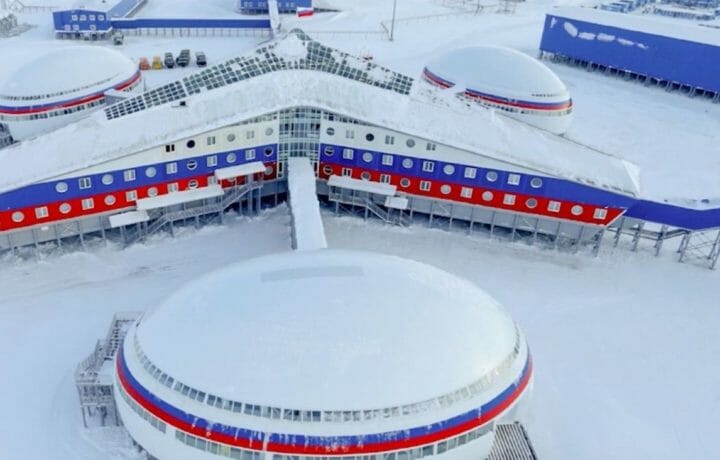After watching numerous incidents, it’s clear that Russia and China have collaborated and conducted some shared gray zone strategy over the past few years. Similar to Beijing’s uncompromising strategy of expanding their military and geopolitical influence throughout South Pacific, the Kremlin broadcasts disinformation and moves forward with their geopolitical expansion agenda. Both countries continue to enhance their international influence with the desire to weaken the appeal of democratic thought, while creating divisions across western nations.
Arctic Expansion for Russia
It appears Russia is fully engaged in the gray zone game with their massive expansions in the Arctic. With the recent enlargement of a runway at its Nagurskoye arctic air base, Russia can now land and refuel most of its military heavy lift aircraft and fighters.
Last week, rare access to the island of Alexandra Land and home to one of several Russian Arctic bases was provided to the western correspondents. Moscow flew CNN, BBC, and other international journalist to the air base in an Ilyushin Il-76, designed to deliver heavy machinery to remote locations. Nagurskoye arctic air base houses around 150 soldiers. When a CNN reporter asked if Russia’s heavy strategic bombers, like the TU-95 “Bear,” were able to operate from the base, commander Maj. Gen. Igor Churkin proudly confirmed.
The “mission” of the base is to ensure Russia’s Northern Fleet can function autonomously. One aspect of the mission is for troops to track NATO ships and aircraft, deemed adversarial. “Just yesterday, we saw a NATO reconnaissance plane. We accompanied it for four hours by transmitting all the information to the higher command centers, the positions of the plane and its trajectory…” Churkin said. “The enemy will not go un-noticed.”
Natural Resources are a Factor
Russian President Vladimir Putin says these facilities and operations are key to bolstering Moscow’s presence in the Arctic, ensuring the “the future” of Russia. During a televised conference call on Thursday, Putin stated, “They should know, those who are going to do this, that we will knock out everyone’s teeth so that they cannot bite anymore … and the key to this is the development of our Armed Forces.”
The visit, being called a show of force, coincided with a meeting of the Arctic Council, a high-level group of eight nations bordering the northern polar region. Interestingly, 53% of the coastline of the Arctic Ocean is Russian territory. Russia took up the chairmanship of the council this year.
In 2007, Russian divers planted a Russian flag on the Arctic Ocean floor at the North Pole. The move was criticized by Canada and others. At the time it appeared the North Pole flag-planting was symbolic. However, Moscow, like China in the Pacific, has been methodically strengthening its airfields and bases at locations along its Arctic coast.
These enhancements are not just a parade of military capability. Natural resources are also a key focus according to many observers. Recent escalation of tensions in the Arctic is partially due to changing of shipping lanes due to global warming. As temperatures rise and the polar ice caps melt, the Arctic becomes more accessible militarily and economically. Russia realizes its far northern regions will soon become a new frontier and has a gray zone expansion strategy, similar to Beijing. Moscow’s three-pronged strategic development of this area includes enhancing military strength, domination of the Northern Sea Route as the ice recedes, and the exploitation of natural resources such as gas and minerals.
U.S. Response to Russia and China
Other than rhetoric, it does not appear the U.S. has a containment strategy for the Russian activities – at least on the surface. President Joe Biden commented during a Coast Guard Academy address on May 19 that the U.S. must defend open and safe sea lanes in the Arctic and South China Sea as adversaries seek to assert greater control over maritime regions. “That’s why we are so adamant that these areas of the world that are the arteries of trade and shipping remain peaceful — whether that’s the South China Sea, the Arabian Gulf, and, increasingly, the Arctic.”




